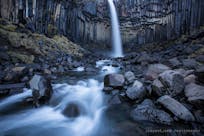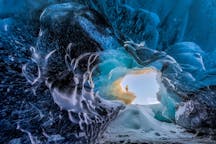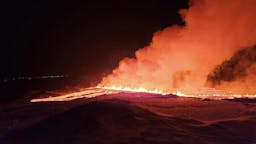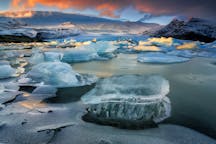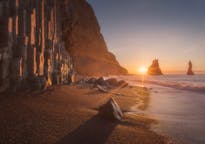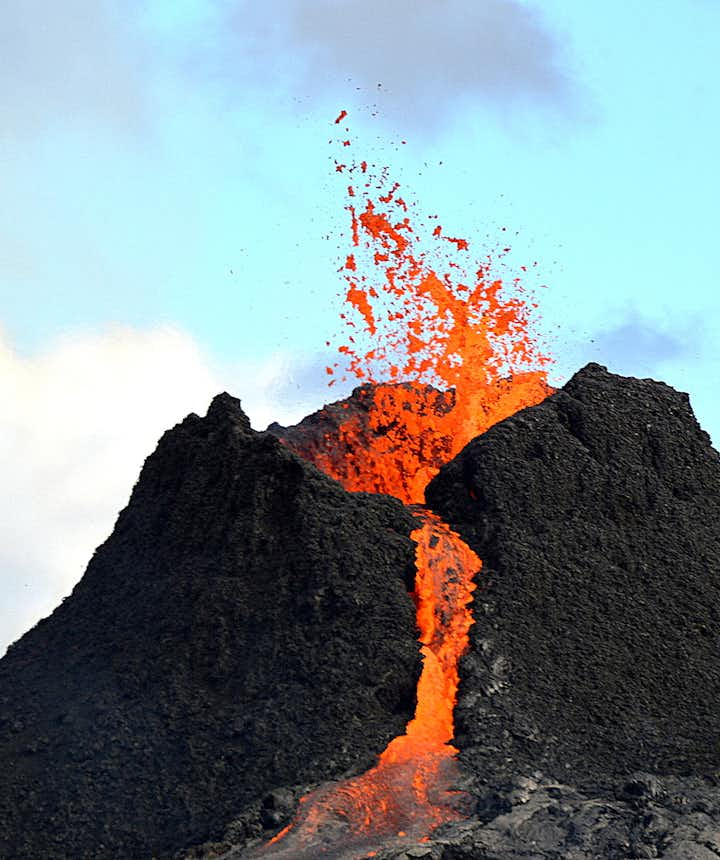
The Volcanic Eruption in Mt. Fagradalsfjall and Geldingadalir in SW-Iceland


After 3 weeks of almost constant earthquakes, approximately 40,000 of them to be exact, which were driving us crazy here on the south-west corner of Iceland, we finally got a volcanic eruption at Geldingadalir by Mt. Fagradalsfjall on the Reykjanesskagi peninsula.
A crater opened in Geldingadalir which spew out primitive molten lava 17 km from the Earth's mantle, something that is quite out of the ordinary - but then this volcanic eruption is out of the ordinary as there has not been a volcanic eruption in this location for some 6,000 years!

The volcanic eruption
When I say that we finally got a volcanic eruption, then I don't mean that we wanted a volcanic eruption in this location so close to the international airport, but the earthquakes were just so frequent that they were making many of us seasick and scaring the living daylight out of us.
The first earthquake on the 24th of February was 5.7 on the Richter scale and we could feel it all too well in the Great-Reykjavík area, which is 30 km away from the eruption, not to talk about the people living on the Reykjanesskagi peninsula.
Constant smaller earthquakes followed in its track and the nation was glued to the webpage of the Met Office which showed us the size and location of the earthquakes. The webpage crashed more than once as we were constantly checking how big the latest earthquake was that we were feeling.
Hot lava flow beneath the lava
Then the geologists started telling us that we might be facing a volcanic eruption! We didn't know what was going on as we have never experienced volcanic eruptions in this part of Iceland in our lifetime i.e., although we are well aware that there are many volcanos and lava fields on the Reykjanesskagi peninsula.
But to us, that was ancient history with very old lava fields. The last volcanic eruption on the Reykjanesskagi peninsula was some 800 years ago.
I packed a bag with my meds and extra clothes and slept fully dressed for the first days of these earthquakes, just to be prepared for the worst-case scenario. And I know a lot of people on the south-west corner who did the same thing ;) 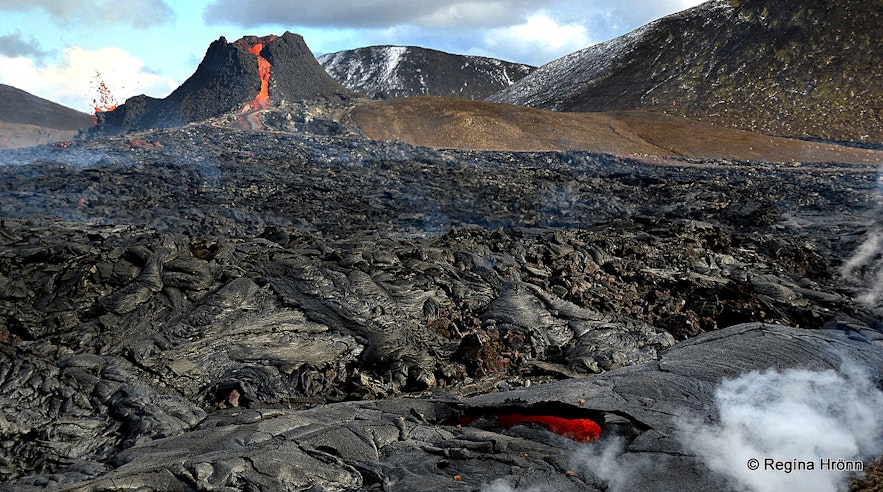
The volcanic eruption and the new lava field
The geologists told us that magma was trying to find its way out, which would then most likely cause a volcanic eruption, where and when we didn't know. But when the magma would find an outlet then most of the earthquakes caused by it would stop. It was a bit nerve-racking waiting for the eruption and there were many speculations about where and when or if it would erupt.
Then, on a Friday night on the 19th of March, while we were watching the telly we saw on the live Icelandic show we were watching that a volcanic eruption had started - some 40 minutes earlier! We jumped from the sofa and panicked a bit - I guess that is just normal behaviour when you live close to a volcano. I cannot even begin to imagine though how the people of close-by Grindavík town felt.
Then there was a news broadcast with breaking news - a volcanic eruption has started by Mt. Fagradalsfjall - in Geldingadalir valleys! I had heard of Mt. Fagradalsfjall but never of Geldingardalir valleys. Now every Icelander knows where Geldingadalir valleys are located.

The new lava field is in the making
And we were told that this was the best location for the magma to escape, as it were, for a volcanic eruption to take place, as it was far from inhabited areas - 3 km away from Grindavík town. And in a valley, which would keep the lava flow in check, at least for a while, until the valley would fill up.
There had been so many speculations about where and if there would be a volcanic eruption and if it would flow to the sea or over Suðurstrandarvegur road. Now, at least it was in a good place, so to speak, actually the best possible place.
And it was a small eruption they said, a wretch (ræfill) really (their words). At least compared to the Eyjafjallajökull eruption back in 2010. This one would not stop any air traffic for sure.
And then the nation started flocking to see the small volcanic eruption!
The nation went wild and even inexperienced hikers in sneakers and jeans were hiking to see the volcano, as if they were going for a short walk, not hiking for hours over rough terrain to see a volcanic eruption.
It was beautiful watching the people with headlights who were visiting the volcano at night creating a beautiful long lit up line, it looked like a pearl necklace.
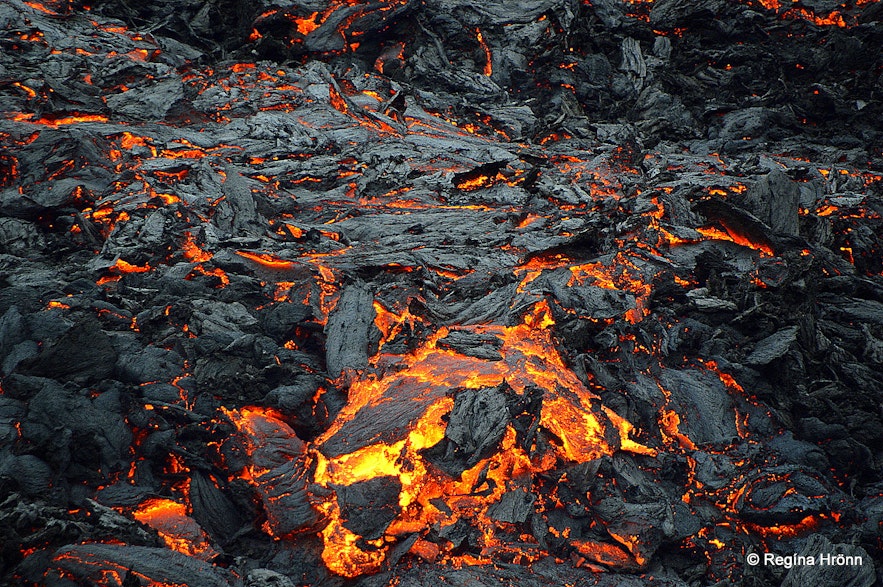
Hot lava
There were many helicopters flying over the volcano. Finally, after a long COVID draught, the helicopter companies were having a lot of business, and people were standing in line to visit the scene of the eruption in a helicopter.
And I can tell you that I was tempted to do the same instead of hiking to the volcano. A bit expensive though as helicopter rides go, but it must be a breathtaking experience.
Finally, on the 23rd of May, after 7 weeks of waiting for a helicopter tour, it was my turn. I have told you about it in my next travel-blog: A Helicopter Ride to the Volcanic Eruption in Mt. Fagradalsfjall in SW-Iceland
Here is a video I took on that tour when we landed on Mt. Stóri-Hrútur:
On the first days of the eruption, the hike to the volcano was 3 hours, first on Suðurstrandavegur road which was closed due to cracks in the road caused by the earthquakes, and then over rough terrain.
A 3-hour hike one way in the middle of March in cold weather!
The police and the rescue teams had to rescue several people who were exhausted and had lost their way.
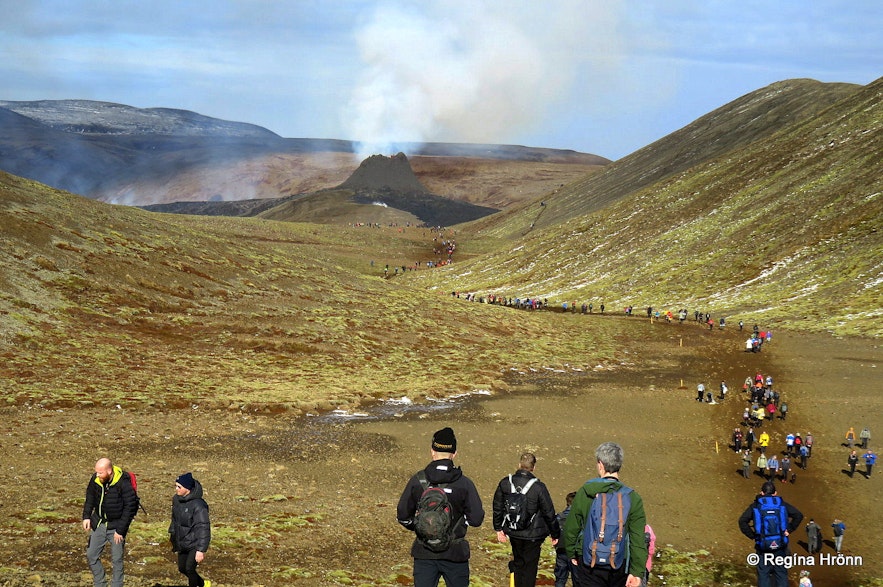
People flocking to see the volcanic eruption
Then the rescue teams opened a track with marker posts making it easier for the herds of people to see the volcanic eruption.
The hike is now approximately 3.5 km which is 1.5 hours one way depending on how fast you walk and how far away from the track you will find a parking space.
When the wind changes the gasses can reach the track and the track is either closed down completely or another track is opened. The rescue teams are volunteers doing their utmost to keep us safe. 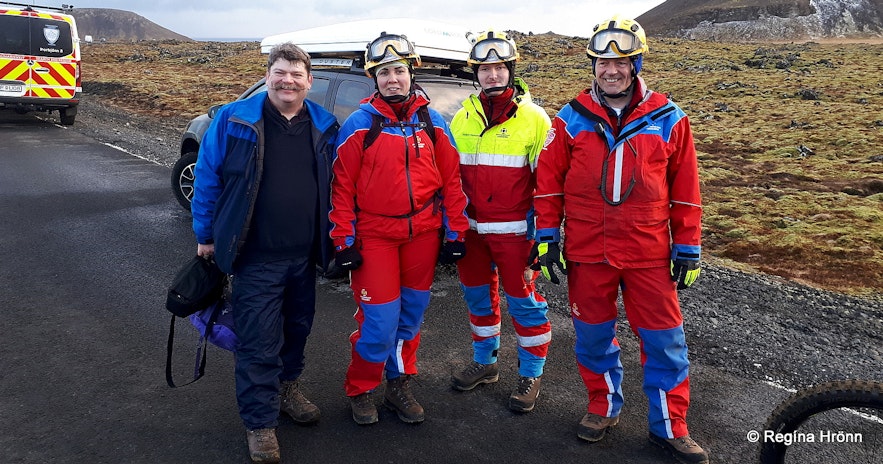
My husband got a photo with the rescue team :)
Kudos to them for a job well done, but they cannot be doing this forever and they themselves have families and work to go to and they must be pretty exhausted by now.
Especially after trying to find lost people in bad weather and keeping the track closed when we are having blizzards or when there is too much poisonous gas by the volcano and on the track.
People have tried to sneak into the area when it is closed making it even more difficult for the rescue teams. And then some tourists who were supposed to be in quarantine came straight from the airport to see the volcano, sic.

People flocking to see the volcanic eruption
And now the police and the epidemiologists were starting to worry about COVID being spread by such a large group of visitors hiking to the volcanic eruption. As more than a thousand visitors were flocking to see the volcano every day, and they were all touching the same rope on the track.
So we were asked to stay away from the eruption, but understanding human nature, we were asked to carry a disinfectant with us if we couldn't stay away from the eruption and disinfect our hands before and after touching the rope.
And we were told to remember to keep a 2-metre distance. And to wear masks by the volcano so as not to spread the virus. These masks don't help in case of poisonous gasses though.
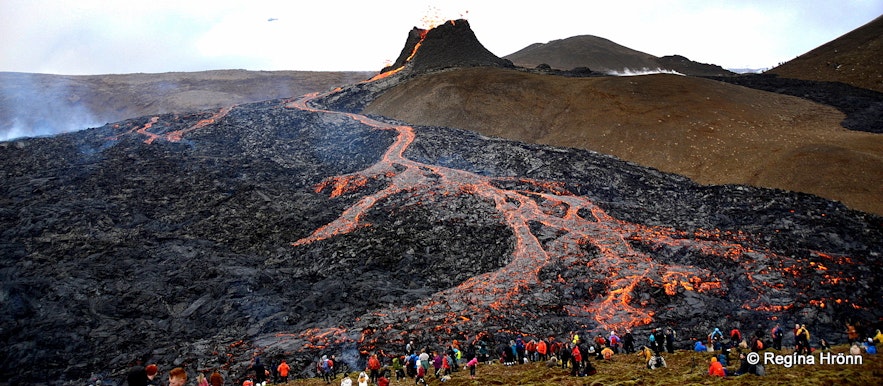
People by the lava flow
In the first days of the eruption, people were getting way too close to the spewing crater and I was watching in disbelief on the telly, where we have a live broadcast from the volcanic area, how some people seemed to be oblivious to the fact that this was a danger zone and not a playground.
I saw that a whole group of people was walking up the slope by the crater, but then I saw them coming down again, as somebody must have warned them of the danger. Only a minute later they were up the hill again and taking selfies right next to the crater!
Were they out of their minds? The crater walls can collapse at any given moment with the 1200 degrees C hot magma flowing from it in a new direction. There is no escape from that and here people were having fun staring right in the face of danger. 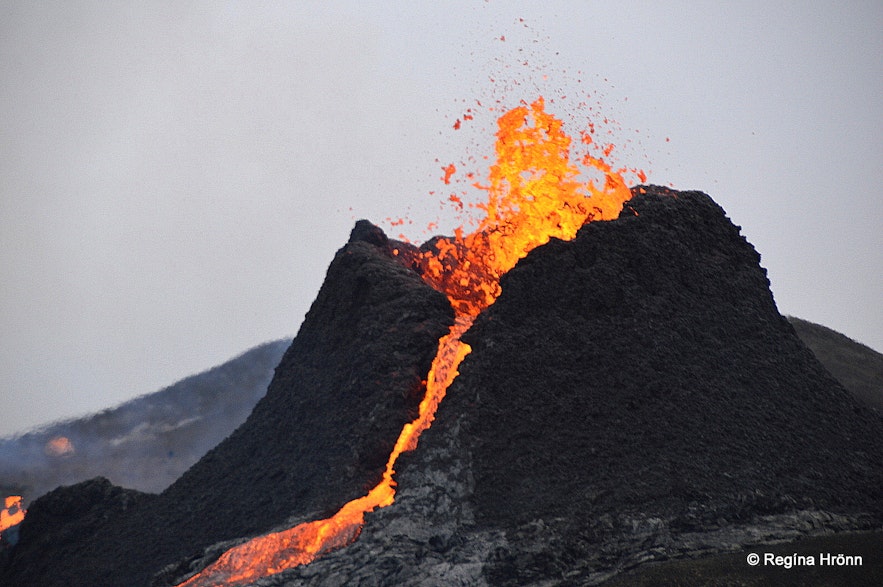
The volcanic eruption
The following day the access to the crater had been closed. And sure enough, the walls of the crater collapsed with hot magma spewing out of it in new directions.
More and more people came flocking to see the eruption, some cooking food on the lava and others lying down on the lava which had cooled down. I say, don't ever do that as the new lava breaks easily and there is most likely molten lava beneath it.
And the new lava is very sharp and can cut through clothes and the soles of shoes causing deep wounds.
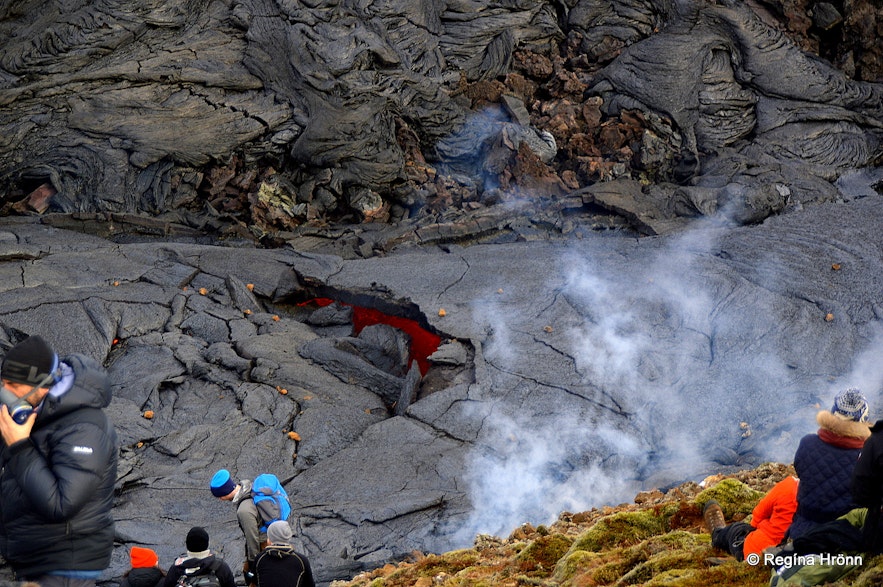
People at a safe distance on a hill above the lava flow
One Icelandic tour guide took his clothes off and had his nude photos taken by the volcano.
But most people were behaving normally and most Icelanders at least know the dangers we can face during volcanic eruptions. Like the poisonous gasses which can kill you in an instant.
These gasses gather in depressions and they cannot be seen ... so don't go too close.
Stay at a safe distance and use zoom to get close-up photos.
If you want to visit this volcano do dress warmly and in woollen clothes beneath your parka. Wear a hat, scarf and gloves. Good hiking shoes are necessary and when the path is icy crampons are needed. It is also good to bring walking sticks and suitable protective clothes in your backpack. Wet tissues and a sealable bag is necessary as there is of course no toilet on site.
Bring something to drink and some food. But always take everything with you when you return back and leave nothing behind.
The police and rescue teams are shocked to see how much trash some people leave behind in nature and even alcohol bottles are left behind, meaning that some people are drinking by the lava flow.

The volcanic eruption
Stay at a safe distance from the volcano and zoom in on it. And stay away from the edge of the lava, there is molten lava beneath it and the edge of the lava can break resulting in the lava flooding from under it at a considerable speed, one of our geologists said. We for sure don't want people to get hurt by the volcano.
My husband visited the volcano on the 23rd of March and took the photos in my travel-blog. On the following day, the 24th of March, which is my birthday, he gave me the photos and a new lava rock from the eruption as a birthday present :)

The volcanic eruption
The volcano is forever changing and a new vent has opened up next to the big one - and now there are 9 vents on the same volcanic fissure.
And in the new lava field from time to time you can see beautiful lava lakes. This is quite an extraordinary and thrilling experience. But at the same time very dangerous to stand too close to the lava.
Reykjavík Excursions started driving people in their big buses to the start of the hike. And I was glad that they were finally getting some business as the tourist industry has suffered big time due to COVID.
But the following day there were new COVID restrictions as our kids were all of a sudden getting sick from the British COVID variety - which put a stop to the big buses transferring passengers to this area, but smaller buses were allowed with departure twice a day. 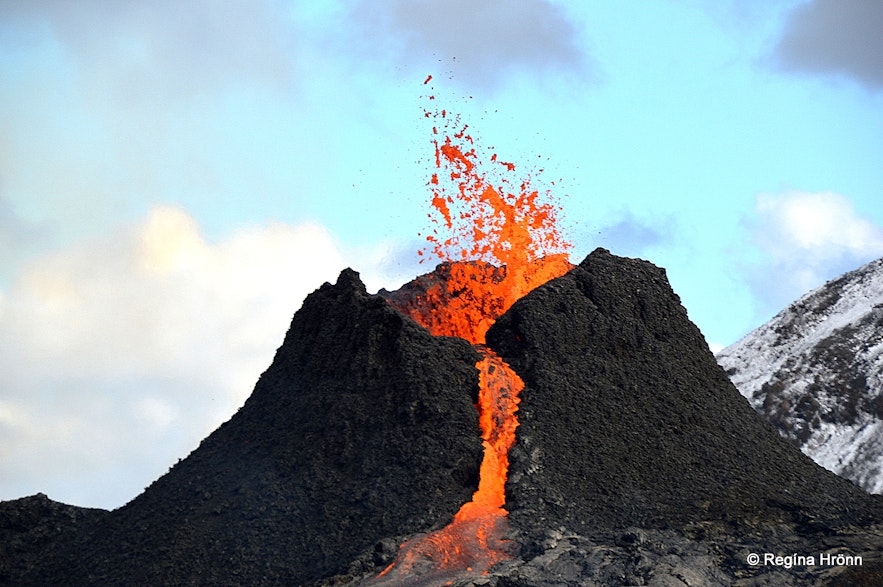
The volcanic eruption
A parking lot was added on the 28th of March, but before that people were leaving their cars by the road. The changes are so quick that I can barely keep up with them. Again, kudos to the police and the rescue teams.
We don't know for how long the volcanic eruption will last or if there will be other volcanic eruptions in this area following this one, which hasn't even got a name yet. This might be the beginning of a new era in the southwest corner of Iceland, or the eruption can fade soon, nobody knows.
Please don't stop in front of the camera, it is extremely annoying and damaging. The recordings are used by scientists and geologists to see the development of the volcanic eruption.
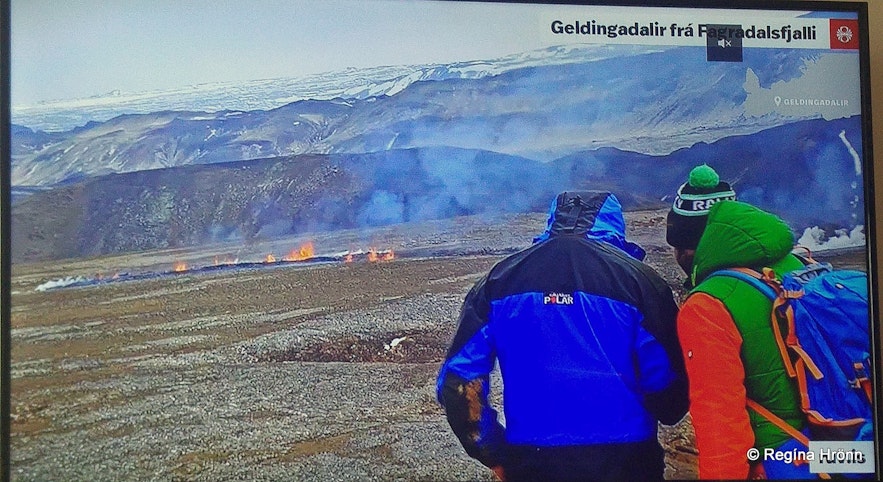
Please don't stand in front of the camera, or dance and wave
We are recording live history here and having people blocking the camera with stupid dancing and waiving is very frustrating.
On the 5th of April, new fissures opened up in Meradalir and the track was moved so the most difficult part of the hike, the hill with the rope, was bypassed.
And a month later the volcano started behaving strangely, only 1 vent of 6 became active, then stayed silent for a while and then erupted high into the air, so it started behaving more like a geyser really.
In May the new lava field got the name Fagradalshraun lava field, which is a pretty name- the Lovely valley lava field :)
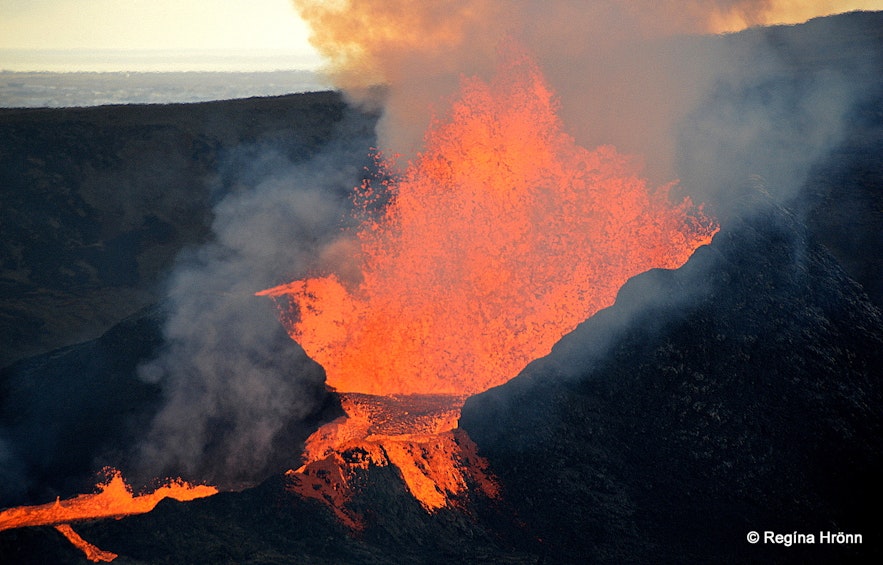
Photo taken of the eruption in May 2021
The earth is a living creature and never ceases to amaze us, that is for sure.
Here you can see a virtual tour of the hike to the volcano.
Before hiking to the volcano always check out the conditions on the eruption site at Safe Travel
Reykjanesskagi peninsula is a member of the UNESCO Global Geoparks and who knows if the volcanic eruption lasts then it might become the biggest tourist attraction on the peninsula, together with the Blue Lagoon.
Have a lovely time in Iceland and be safe :)
Other interesting blogs
Chasing Waterfalls in Iceland
Iceland is spectacular in so many ways and Icelandic nature is quite unique with its vast landscape, volcanic activity, geothermal areas, glacier lagoons and sceneries, black sand beaches and spectLäs merSænautasel Turf House in the Highland of Iceland
In my search for turf houses around Iceland, I visited Sænautasel, which is a rebuilt turf house on Jökuldalsheiði heath in the highland of Iceland. It is, in my opinion, an extremely cute turf hoLäs merThe Dynamic Plant Lupine
People have been asking me where to find lupines in Iceland. If you like them you should be able to find them easily in Iceland in summer. They are in bloom and visible almost wherever you drive aroLäs mer

Ladda ner Islands största resemarknadsplats i din telefon för att organisera din resa på ett ställe
Skanna den här QR-koden med din telefonkamera och tryck på länken som visas för att få tillgång till Islands största resemarknad i fickan. Lägg till ditt telefonnummer eller din e-postadress för att få ett SMS eller e-postmeddelande med nedladdningslänken.
